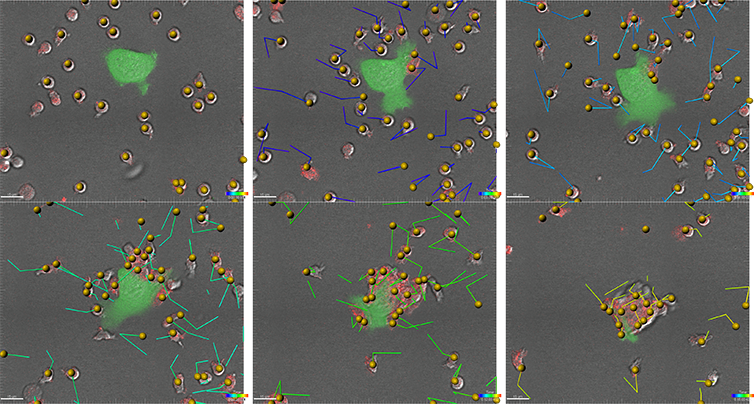Applications
 Part of the Oxford Instruments Group
Part of the Oxford Instruments Group
Expand
Collapse
 Part of the Oxford Instruments Group
Part of the Oxford Instruments Group
Immunotherapy is a new type of treatment that uses the body’s own immune system to fight cancer. Although it is an important treatment option for many cancers, immunotherapy doesn’t work for every patient, especially those with solid tumors.
Niels Heemskerk and colleagues from the Amsterdam University Medical Center are using Imaris image analysis software to aid in their development of a new type of immunotherapy. The new therapy could lead to an important alternative treatment for cancer patients who don’t respond to today’s immunotherapies.
Most of today’s immunotherapies use anti-cancer monoclonal antibodies (mAbs) of the IgG isotype, which eliminate tumor cells through processes that mostly involve natural killer cells. However, studies have suggested that innate immune effector cells could also help find and attack cancer cells.
To more fully harness the immune system’s cancer-fighting capability, Heemskerk and colleagues developed an improved bi-specific antibody named TrisomAb that recruits neutrophils as well as natural killer cells and macrophages to eradicate of tumor cells. “The recruitment of neutrophils is not possible with conventional IgG-type antibody formats,” said Heemskerk. “Thus, TrisomAb is an important addition to the growing arsenal of anti-cancer antibodies.”
To watch TrisomAb in action, the researchers studied dynamic contacts between neutrophils and tumor cells in real time. They did this by performing live-cell imaging followed by in-depth tracking analyses performed with Imaris. “We choose Imaris because it contains good algorithms to track cells over time, which helped us to follow neutrophil-tumor interaction during antibody-dependent cellular cytotoxicity (ADCC),” said Heemskerk. “It also allowed us to run the Kiss and Run XTension.”

Researchers used Imaris and the Kiss and Run XTension to follow neutrophil-tumor interaction during antibody dependent cellular cytotoxicity.
The Imaris Kiss and Run XTension was written by Matthew Gastinger to calculate contact events between two different surface objects or a spots object and a surface object. To use this Xtension to quantify neutrophil-tumor interactions in cells, the researchers created a new Imaris spot object for neutrophils and a new surface for tumor cells. The analysis produced a variety of statistics on neutrophil and tumor cell behavior, including the number of interactions, distance to tumor, longest contact and tumor area.
The combination of image analysis and functional ADCC experiments revealed that the TrisomAb molecules recruited natural killer cells, macrophages and neutrophils as effector cells for eradication of tumor cells in vitro. Additional experiments showed that this also occurred in mice and in tumor cells from patients with colorectal cancer.
Next, the researchers are working to improve infiltration of innate immune cells into solid tumors. They plan to continue to use Imaris to measure cellular interaction within the tumor microenvironment. In particular, the interactions of innate immune cells with the tumor vasculature. As the vasculature is an important gateway to enter the tumor microenvironment.
Movie courtesy of Niels Heemskerk, Amsterdam University Medical Center.
Date: March 2021
Author: Niels Heemskerk, Marjolein van Egmond and colleagues, Amsterdam University Medical Center
Category: Case Study
